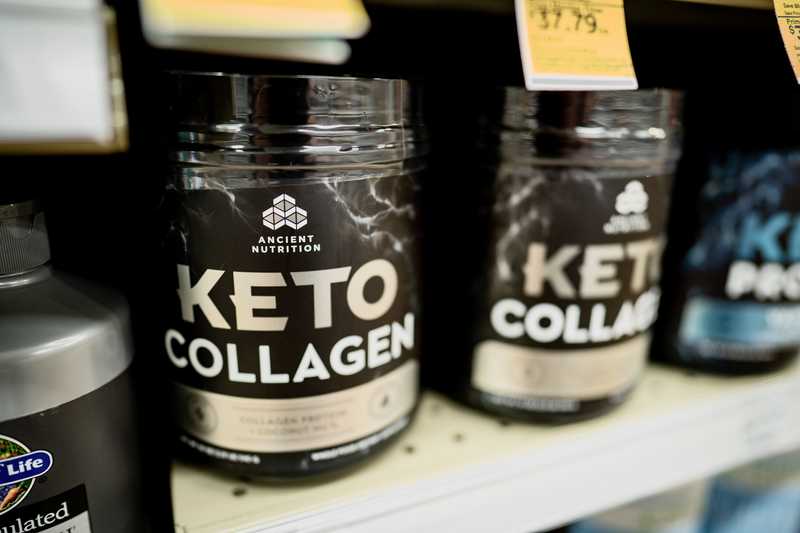Previously in this 3-part series, I covered how the sugar, caffeine, and other compounds in your morning coffee or latte may be contributing to your achy joints. We still have one major component of most people's coffee to tackle so that you can decide what should be in your morning drink: Dairy!
In this final installment, I'll address how the dairy, such as milk or cream, in your latte relates to inflammation and knee pain (or any kind of joint pain).
Did you know that 30 million Americans are allergic to lactose, the natural sugars found in dairy?1 Find out what that means for your joint pain below!
Table of Contents
- Dairy, Knee Pain, and Inflammation
- Easy Substitutes for Coffee with Less Inflammation and Joint Pain!
- The Bottom Line
Dairy, Knee Pain, and Inflammation
If you lived through the 90s, you may recall the "Got Milk?" billboards everywhere boasting milk as a health food. Many studies illustrate the health benefits of eating dairy as a good source of calcium, protein, and vitamin D.2 Yet, there is also plenty of research and case studies showing that dairy is inflammatory for some people, particularly those with arthritis.
With a large chunk of the population (estimates range from 10 to 60%) allergic to lactose, dairy can certainly lead to an overloaded immune system and a low-grade inflammatory response within the body. Ultimately, this can leave you feeling sore and wondering why?
Dairy and Auto Immunity
Research from 2016 found that both egg and dairy proteins triggered rheumatoid arthritis (RA) inflammatory markers and increased the specific food immunoglobulins IgG and IgE, linked to allergies, in mice.3
That means that when the mice were fed eggs and dairy, their bodies had an immune reaction to those foods. This also increased other inflammatory compounds associated with the breakdown of cartilage and the symptoms of RA.
This is known as molecular mimicry: when the body reacts to something entering the body by attacking its own healthy tissues. It occurs because some of the compounds in dairy are molecularly similar to native tissues.4 Ouch!
Try Cutting Out Dairy to See How Your Joints Feel
When I have patients stop consuming dairy, oftentimes their joint pain decreases or goes away completely. It's quite remarkable!
I specifically recall a patient who stopped eating all dairy and gluten containing foods and her RA antibodies dropped drastically. Best of all, she no longer had joint pain.
A year later, she called and said her pain was back but she hadn't changed her diet. As I took a very detailed diet recall from her, it became clear she had unintentionally changed her diet – she had started adding goat's milk cheese to her salads! It all started when someone told her goat's cheese was less inflammatory than cheese from cow milk.
Clearly, for her, this was not the case. Within a week of stopping the goat cheese, her pain was gone again.
What counts as dairy?
- All milk
- Cheese
- Yogurt
- Sour cream
- Cream cheese
- Ice cream
- Pudding
- Heavy cream
- Whipped cream
- Butter
- Whey/casein protein powders
Dairy is also hidden in many different foods such as salad dressings, canned soups, and crackers. If you choose to cut out dairy to see if it is affecting your joints, make sure to read labels carefully.
How to reduce your dairy intake effectively
Now you might be thinking, "I'll just switch to the new oat-milk lattes!" Think again.
Even a honey oat-milk Latte comes in at 270 calories, with 42g of carbohydrate, 28g of that being from added sugar.
Since this milk alternative is made from a grain, it's automatically higher in carbs than almond or coconut milk. And the honey is just more added sugar. Despite being dairy free, this alternative still turns into 10.5 teaspoons of pain-inducing sugar in your body, keeping your joints inflamed and your knees creaky. (In case you forgot, we want to keep added sugar intake under 9 teaspoons!).
If you missed it, don't forget to read Part 1 of our series that discusses the link between sugar and joint pain.
Coffee Creamer and Your Joints
Maybe you don't drink lattes or mochas or anything with whipped topping, but do you add 1 to 5 of those little cups of creamer to your coffee?
Or is there a bottle of Coffee Mate in your fridge?
I remember using those little hazelnut creamers during my early mornings working at a long-term care facility while in college. At the time, I didn't know I was unwittingly increasing my own inflammation. Plus, these little pods were also contributing to the inflammation for the residents too!
How coffee creamer is causing inflammation
Products such as Coffee Mate or International Delight are mainly made of water, cane sugar, sodium caseinate (dairy), partially hydrogenated vegetable oil, and artificial flavor. As you now know, the sugar and dairy in these products are inflammatory. A double ouch!
But even more concerning is another ingredient: the partially hydrogenated vegetable oil. These types of oils are bad for everyone.5 Entire books have been written about their toxicity to our bodies. Thus, it's best to avoid them altogether.
What to use instead of traditional coffee creamers
Instead of these artificial creamers, simply try using real heavy cream to add some creaminess to your morning blend (without the side of inflammation from all the sugar and cringe-worthy additives).
And for those creamer lovers who need dairy free (you won't know until you try!), switch to one of the many new brands of dairy free creamers such as: Califa, Nut Pods, Ripple, or Laird Super Foods, and Natural Bliss. From now on, steer clear of the coffee mate selection, no matter how tasty you think it is.
With any of these brands, there are sweetened and unsweetened options. Read the labels and choose whichever works best for where you are on your health journey.
Easy Substitutes for Coffee with Less Inflammation and Joint Pain!
As I mentioned in Part 1 of this series, I used to enjoy getting the occasional almond milk latte on my way to work. It came in at only 100 calories, with 10g of carbohydrate, and only 5g from added sugar (about 1 teaspoon).
You can also save yourself some cash and invest in high quality organic coffee beans and brew your coffee at home. I do recommend organic coffee to people who consume it daily, since coffee trees are typically sprayed with a large amounts of pesticides (a whole other cause for inflammation and potential joint pain).
Other alternatives
Once you've brewed your morning coffee, then add in your own creamer. You can also try some chocolate collagen powder for a protein boost that actually supports your joints.
Want a different flavor? Sweet Leaf stevia drops can be added to give you that hazelnut, vanilla, or even pumpkin spice flavor that you're looking for. (Make sure you try one before you go all out on purchasing flavors since some people find they don't like the taste of stevia.)
Want it frothy but can't invest in an espresso machine? Try using a little coffee whisk to create the frothy topping you love. (These also make great gifts.) Have fun experimenting and finding a new creation that doesn't create joint pain.
Getting started with simple changes
No matter how you choose to change up your morning latte, remember little steps count. Maybe this week you try ordering your drink with a different milk such as almond, coconut, or soy. Or you purchase a non-dairy creamer to use at home. These are all amazing steps in the right direction!
So what is the right first step for you? Cut down on sugar? Swap Coffee Mate for real cream? Switch to decaf?
If you're feeling unsure, the best thing to do is just get started. I recommend keeping a food journal so that you can keep track of how you feel as you make changes. That way you know what is making the most impact for your joint pain and other aspects of your health.
The Bottom Line
After reading through this series, it should be clear that there is no singular answer to making healthy changes to your morning coffee. What a coffee will look like for each person will depend on their goals, how they're feeling, and their overall preferences. There's no right way to approach a "healthy" cup of coffee.
Instead, I hope you take all this information and use it as you deem appropriate for your life. The key is to pay close attention to how you feel, specifically your joints, to figure out what helps you feel your best. You can do so by keeping a food journal as I mentioned, or by working with a registered dietician.
CityPT clinicians are dedicated to addressing the whole person and love providing education about the right foods to help meet your goals of reducing joint pain. We are here to help you when you need a little extra support!
Get the support you need to live your best life today!
Before you go, please read our disclaimer. This blog is intended for informational purposes only. We are not providing legal or medical advice and this blog does not create a provider-patient relationship. Do not rely on our blog (or any blog) for medical information. Always seek the help of a qualified medical professional who has assessed you and understands your condition.
References
Footnotes
-
Lactose Intolerance. Medline Plus. Accessed February 20, 2022. https://medlineplus.gov/ency/article/000276.htm#:~:text=Lactose%20intolerance%20is%20very%20common,children%20older%20than%20age%205. ↩
-
Dairy: Health Food or Health Risk? Published January 25, 2019. Accessed February 18, 2022. https://www.health.harvard.edu/blog/dairy-health-food-or-health-risk-2019012515849 ↩
-
Li J, Yan H, Chen H, et al. The pathogenesis of rheumatoid arthritis is associated with milk or egg allergy. N Am J Med Sci. 2016;8(1):40-46. https://www.ncbi.nlm.nih.gov/pmc/articles/PMC4784182/ ↩
-
Cordain L, Toohey L, Smith MJ, Hickey MS. Modulation of immune function by dietary lectins in rheumatoid arthritis. Br J Nutr. 2000;83(3):207-217. https://pubmed.ncbi.nlm.nih.gov/10884708/ ↩
-
Kummerow, Fred. The negative effects of hydrogenated trans fats and what to do about them. Atherosclerosis. 2009;205(2):458-65. https://pubmed.ncbi.nlm.nih.gov/19345947/ ↩

Brenna holds a Master's in Applied Nutrition from Northeastern University in Boston and a Bachelors of Science in Dietetics from Minnesota State University, Mankato. She is passionate about teaching people how foods interact with their body and helping them learn how what they eat affects how they feel.

Brenna holds a Master's in Applied Nutrition from Northeastern University in Boston and a Bachelors of Science in Dietetics from Minnesota State University, Mankato. She is passionate about teaching people how foods interact with their body and helping them learn how what they eat affects how they feel.




